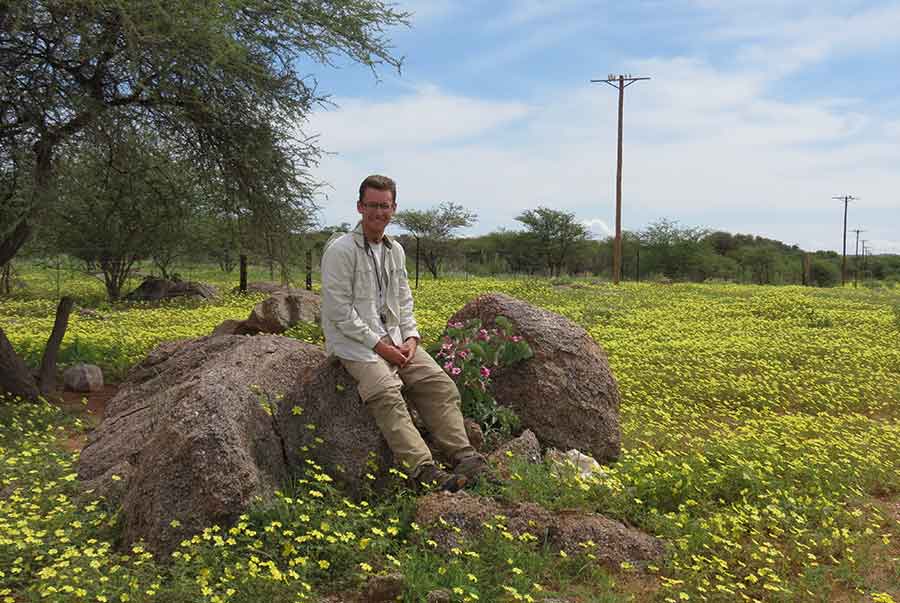When It Rains, It Pours
Posted on Sun., Aug. 3, 2014 by
The fruits of a return trip to Namibia

Heavy rain on Cody Howard's return trip to Namibia rewarded him with a sea of Tribulus flowers near Kamanjab. Moist conditions made it much easier to find Ledebouria bulbs. Photograph by Leevi Nanyeni.
The Spring/Summer 2014 issue of Huntington Frontiers featured Huntington conservation technician Cody Howard's search for Ledebouria bulbs in the bone-dry landscape of Namibia. As that issue went to press, Howard embarked on a second trip. This time, five days of heavy rain pelted the dirt roads, forcing Howard and his colleague, Leevi Nanyeni, to slow their truck to a crawl. "We got a flat tire one day, I fishtailed the truck 180 degrees another day, and then the truck sank in mud up to the rim of the passenger side," recounts Howard.
Thankfully, after this initial "trial by rain," the skies cleared and Howard enjoyed perfect conditions for finding bulbs—sunny skies and moist soil that eased Ledebouria out of its winter slumber. Howard and Nanyeni covered 4,400 miles and found Ledebouria almost wherever they went, sometimes coming upon hundreds of thousands of a species. "It was a bulb fanatic's dream," gushes Howard.
The abundant rainfall meant Howard found many more plants than on the first trip, and he could take the time to zero in on Ledebouria scabrida, the one species he identified with certainty. The Pacific Bulb Society had awarded him a grant to document the distribution of L. scabrida, and luckily, modern technology lent a hand.
Howard had noticed that L. scabrida grew in areas of chalky soil rich in calcium carbonate, or limestone. When planning his itinerary, Howard used satellite photos from Google Earth to find veins of white, limestone-streaked soil and then marked two spots using GPS. In both cases, he found L. scabrida.
Another bonus of the second trip was that he had an export permit allowing him to ship specimens from both trips back to The Huntington for further research: 80 new plants as well as 50 from the earlier visit. One week after Howard returned to Los Angeles in March, the plants arrived safe and sound at The Huntington's nursery.
Howard's permit also allowed him to take the plants with him to the University of Florida at Gainesville when he left this past August to start a doctoral program. He'll run some tests, including DNA analysis, and write detailed notes of the plants' morphological characteristics. Then he'll prepare dried samples called vouchers, which are stored in an archive of pressed plants known as a herbarium.Duplicate vouchers will go to herbaria in the host country of Namibia and also to The Huntington.
For his doctoral research, Howard is eager to document Ledebouria in other African nations and even in Asia. He's contacted research and permitting offices in Botswana, Mozambique, Zimbabwe, and India, and so far everyone has been enthusiastic.
Researchers knew the plants were out there. They just needed someone with the determination to document them, even if that meant trekking halfway around the globe—twice.
Diana W. Thompson is interim editor of Huntington Frontiers.